

Noisy roads choked with cars and never-ending stretches of beautiful beaches don’t really go hand-in-hand. But they co-exist uneasily in Langkawi, one of Malaysia’s popular island getaways, especially during peak holiday periods.
Telekom Malaysia (TM)’s enterprise and public sector business arm, TM ONE, has created several 5G-powered solutions to tackle this issue and ensure visitors enjoy a smooth journey throughout their holiday. “When you talk about smart tech, it’s not about the technology, but your experience when you touch down in Langkawi,” Maznan Deraman, TM ONE’s innovative solutions head, recently told GovInsider.
TM is testing 11 5G applications in Langkawi in the first half of 2020. Here is how three of them can help transform Langkawi’s roads.
Malaysia already has a series of options for parking apps that make fee payments easier. But TM ONE’s latest smart parking endeavour sets itself apart from the rest. “For the normal parking app we’re used to today, users have to select a parking bay and tell the system how long they’ll be parking for,” explained Azrin Aris, Director of Products & Innovation at TM ONE at a recent media showcase. But this can be inaccurate, and TM ONE is trialling a new feature to reduce human error so the correct fee can be charged.
TM ONE’s parking app shows users live footage of the parking lots, captured by high-definition cameras in the area. Instead of manually keying in the parking lot number, “users just need to tap on the phone to record the exact location of their parking spot,” he said.
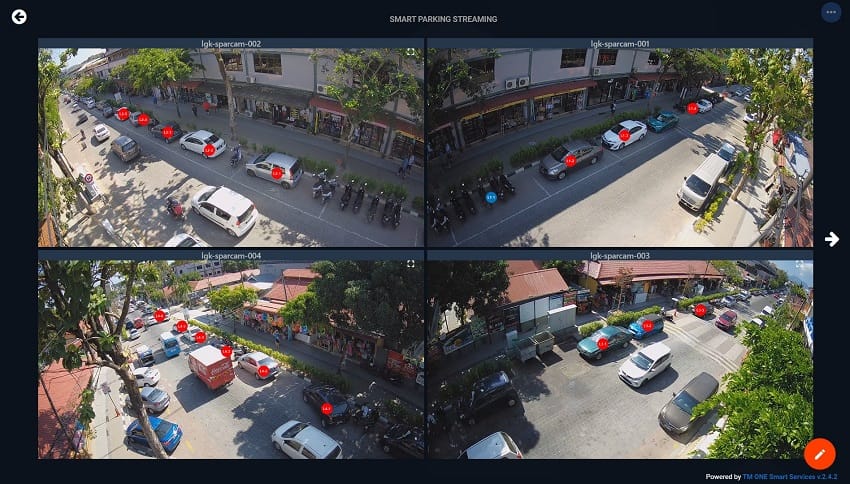
The app will create a seamless experience for drivers – they can start looking for parking spaces and book it through the app even before setting off in their car. Drivers also don’t have to specify how long they will be parking for. Sensors in the parking lots will detect when the car has driven off, and the app will charge the appropriate fees automatically.
The app also helps traffic wardens work more efficiently. They can identify cases of illegal parking through the footage captured on the app, without manually checking up on parked cars. Officials can also find out how long a car has been illegally parked in a spot, so they can issue the appropriate fines.
“We can also look out for traffic violations with the camera,” said Maznan. Traffic wardens can study the footage to look for wayward drivers going the wrong direction in a one-way street, or rogue motorcyclists riding on the pedestrians’ path.
Langkawi’s roads can get quite busy, especially during peak traveling seasons. TM ONE has devised a smart traffic light that regulates traffic flow to shorten wait times.
IoT sensors installed in traffic lights measure patterns such as the average waiting time and how many cars are turning right or going straight. “Previously we didn’t have this information [about traffic conditions]. If we wanted to do this, we had to send people to the roadside to count,” said Maznan.
“The traffic light then uses this data to adjust the green time period. For instance, the traffic light would flash green for a longer time when there are more vehicles passing through. This would mean less congestion, quicker journeys, less fuel consumption, and a smaller carbon footprint,” explained Maznan.
The traffic light also comes with a built-in contingency plan, just in case the IoT sensors malfunction. “We use the predicted values to change the default setting, so it gives time for authorities to fix the sensors while not heavily impacting user experience,” shared Azrin.
Telekom Research & Development (TM R&D), TM ONE’s sister company and TM’s innovation arm, has developed a system for car rental companies to manage their fleet. “Langkawi is a tourist Island and car rentals are the most used mode of transport,” explained Dr. Sharlene Thiagarajah, CEO of TM R&D.
The new tech allows car rental companies to track each vehicle’s usage pattern in real time, using GPS that runs on 5G networks. The system also grades each employee’s driving behaviour by giving a score for each drive.
“Car rentals will know who’s driving your car, where they are going, if there has been harsh braking or harsh cornering, or if there is excessive idling,” said Dr Sharlene. “Car rental operators will then understand the usage pattern and maybe create new business models with the customers.”.
This can change the way insurance companies charge for car rentals as well. “Today, most of us who drive are paying for insurance 24/7. Imagine if we have data to show insurance companies that we are only driving two or three hours a day,” Dr Sharlene said. “Insurance companies could perhaps use this information to offer more tailored packages to customers,” she explained.
These three solutions have the potential to transform Langkawi’s roads and ultimately, its city planning. All the data collected by these systems can be consolidated on a dashboard so officials can understand the city’s needs better. “We want to see where vehicles are going and where people are congregating,” said Dr Sharlene. These are the insights that will help us plan better and safer cities.
Malaysia steps up on rural development initiatives with high-speed internet infrastructure and digital technologies.
The Malay word “kampung” means village but also so much more. It evokes the close-knit collectives who live in rural Malaysia; the antithesis to the atomisation of city living. Villagers rise with the chickens, and sleep when the sun sets. People keep their doors unlocked and look after their neighbours.
Malaysia’s Ministry of Rural Development wants to retain this tradition, while giving rural communities the opportunities provided to their city counterparts. In August, they signed a Memorandum of Understanding with several partners to provide smart solutions, close the digital divide, and build the digital skills of kampung dwellers. One of those companies is TM ONE.
“We want to not only provide infrastructure to people in rural areas, but also strengthen the economy,” said Datuk Seri Rina Mohd Harun, the country’s Minister of Rural Development when the MoU was announced. What will the Smart Village pilot programme look like for Malaysia’s rural regions?
First, there will be high speed internet access - up to 100Mbps. This connection will power smart classrooms and digital libraries, to give young villagers access to education comparable to those available in the cities. It will also allow for “digital marketplaces” so that villagers can sell their wares online.
Hospitals will monitor their patients’ health from city areas and deliver care via telemedicine. Meanwhile, farmers can use drones for smart farming. The Ministry is building a Smart Map, to share data in real-time, and increase flooding awareness.
The pilot programme will start in 191 villages, but the Ministry intends to provide it to 15,000 villages across the country. It helps to bridge the urban-rural divide, promoting new skills and economic opportunities. Entrepreneurs, students and housewives are the primary targets.
For TM ONE, TM‘s enterprise and public sector business arm, the Smart Village initiative is a vital tenet of Malaysia’s broader Digital Malaysia vision. Mohd Nazri Ambi, Director of Public Shared Services of TM ONE explained that there are three parts to building a Digital Nation: digital government, digital business and digital society. “The Smart Village initiative falls under digital society,” he shared.
TM ONE provides connectivity infrastructure to more than 550 rural communities nationwide, with more on the way. “We want to include rural areas in our smart society,” said Mohd Nazri. “We want to become their enabler,” he added.
On a broader scheme, the Smart Village initiative forms part of KPLB’s Rural Development Policy 2030 (DPLB 2030). This is a plan to create prosperous rural community with a focus on 10 areas spanning social, economic and environmental progress. These include the areas of entrepreneurship, human capital, sustainable biodiversity, housing and regional development.
There are high hopes for the Smart Village project. For one, “we want to create more job opportunities for the rural people so that we can minimise the migration from rural to urban regions,” Datuk Seri Rina said of her vision.
Retaining talent has always been a challenge for rural areas, but smart initiatives can be the answer. The project is also expected to boost the economy with its focus on encouraging innovation and entrepreneurship.
The focus on developing human capital instead of economic growth has allowed Malaysia to slash rural poverty rates from over 8 per cent to just 1 percent in 7 years.
Now, the Smart Village Project is that next step: building up opportunities, while retaining that crucial kampung spirit and charm.
Malaysia has its eyes set on achieving the developed country status, and they are well on track for achieving it. The country’s gross domestic product (GDP) growth has been climbing steadily and the MIDF Amanah Investment Bank Bhd Research foresees higher GDP growth in the second half of 2019, according to Malay Mail.
But, as with many other countries before it, it needs to avoid the middle income trap and prepare for unprecedented disruption to global industries, including manufacturing. “Malaysia’s forte is in manufacturing-related angles,” noted Jeyasigan Nair, Director of Advanced Technology, Research and Development, Malaysian Investment Development Authority. “Manufacturing is one of the pillars to push for us to attain the status of a developed country,” he said at the TM ONE Smart Industry Showcase in Kuala Lumpur recently.
Enter Industry4WRD, Malaysia’s iteration of Industry 4.0. This is the country’s first step in embracing the digital revolution that has transformed public and private sectors across the world, and it will focus on driving growth in manufacturing and related industries. TM ONE, leading digital solutions provider and Telekom Malaysia’s enterprise and public sector business arm, has recently launched 10 Transformative Smart Solutions to support Industry4WRD during the Smart Industry Showcase. These solutions use big data, IoT sensors and smart technology to create smart systems across multiple industries.
TM ONE recently spoke to GovInsider on the practical ways to achieve Industry4WRD.
At the Smart Industry Showcase, Ir Ts Azizi A. Hadi, former EVP and CEO of TM ONE and currently Telekom Malaysia’s Chief Network Officer, shared some ways that TM ONE supports the development of Industry4WRD.
1. Smart buildings
TM ONE’s Smart Building Management Solution optimises energy usage with a three-pronged approach: integrated third party sensors, smart analytics and advanced visualization tools. Building managers can collect data and control devices within the building through a centralised monitoring platform. The data can provide insights on footfall, traffic and asset’s usage. It can also tell maintenance teams when would be the best time to carry out maintenance work, ensuring a safe and comfortable experience for tenants.
“Data from energy usage can provide insights on bigger things,” said Azizi. For example, when the electricity bill is higher than projected, it could be a sign of a mismanaged air conditioning system. Building managers can then choose to install a centralised and automated control system based on demand.
“Without these data systems, we cannot identify where the waste is coming from. And when you introduce energy savings equipment, we can easily measure the KPIs with these data,” he added.
This energy monitoring system is currently in trial in several government buildings across Malaysia.
2. Smart farming
The agriculture industry, in particular hydroponics, can benefit greatly from Industry 4.0 technologies. Sensors can detect the pH level and temperature of the plants’ environments using electrolytes in the water. This data can then be transmitted onto a central system accessible through mobile phone. Farmers can also control the plants’ environment in real time if anything is out of place. For example, they can turn on the air-conditioning if it becomes too warm or they can engage the system to automatically dispense fertiliser if fertiliser concentration is too low. Farmers can also glean insights on crop data and patterns from the data collected to optimise their yield all year round.
Smart systems like these can also be used beyond hydroponics on any type of farming - it can be used to check on soil acidity and water level, for instance. One of the premises in the Malaysian Agricultural Research and Development Institute has installed and started running this system.
3. Smart traffic
In cities like Kuala Lumpur, people spend almost a whole hour being stuck in traffic in their daily commute, according to the TomTom Traffic Index. This may be set to change, however, with the introduction of smart traffic lights from TM ONE.
These traffic lights reduce waiting time at junctions, effectively reducing both traffic congestion and carbon emissions. They can also monitor traffic in real-time and collect data about road usage. This data can then help in future road-building and town-planning.
Sensors installed beneath roads, together with smart devices such as cameras, collect real time information which enable traffic lights to adapt their timings according to the volume of passing traffic. If the sensors identify that there are no cars, it will send data to the traffic light controllers, which will increase the amount of time for pedestrians to cross the road. The controllers will also adjust the time according to the demand of each lane - the longer the queue, the more time will be given to that particular lane. When a part of the system fails, it will automatically send a Telegram notification to maintenance teams. This smart system can also be upgraded to cater to other demands in the future, such as clearing road lanes for emergency vehicles.
TM ONE focuses on customer centricity in the implementation of these 10 solutions. “We find customers and work with them to test our solutions. That way, we can have two to three iterations of the product before it even hits the market,” said Azizi. The traditional business models required customers to mass purchase a smart device or a piece of infrastructure, which is costly. Now, customers can start with buying just one traffic light, or a hundred, making the barrier for upgrading to emerging technologies a lot lower for organisations.
In Malaysia’s journey to adopting Industry 4.0 technologies, people have to develop the appropriate skillsets to keep up with the advancement of emerging technologies. Jeyasigan and Hj Ghazali Juhari, Head of Business Development at UMW Equipments shared their thoughts on how this can be done.
“Industries and departments have been working separately, but the needs of industries are different today,” Jeyasigan said. “It’s not just about studying IT or mechanical engineering,” added Hj Ghazali. “People need to have an interdisciplinary skillset.” Some universities have already introduced modules about data and information technology for students of all degrees and disciplines.
Governments around the world have implemented various emerging technologies - and Malaysia will not be left behind. This is why the Malaysian government has budgeted RM 210 million (USD 5 million) from 2019 to 2021 to support the country’s shift to Industry 4.0 technologies.
The Malaysian government is armed and ready to make changes with a collaborative mindset. “As a global economy, Malaysia is a nation that heavily depends on trade, investment and services,” noted Jeyasigan. “We will never survive alone.” Internationalisation is one focus for Malaysia in their Industry4WRD plans.
Digitalisation is another priority. “Industry 4.0 is all about digitalisation,” according to Ahmad Fairuz Bin Mohamed Noor, Principal Assistant Director from the National Cyber Security Agency (NACSA). The organisation has come on board to facilitate cybercrime awareness and protection in the country. Cyber technology is now the main enabler for every sector, according to Ahmad Fairuz. “It’s not limited to communication or information technology per se. Many services are highly dependent on digital technology,” he added. On top of cybersecurity boosts, 5G trials have already begun in several states in Malaysia beginning October 1, reports The Star.
TM ONE recently joined hands with Malaysia’s Ministry of International Trade and Industry to support the Readiness Assessment (RA) initiative for Industry4WRD. This initiative, which started in July 2019, helps manufacturing companies understand how eligible they are for adopting emerging technologies. Assessors will also recommend strategies and areas of improvement for adopting Industry 4.0.
Malaysia is taking bold steps to propel its economy forward with the deployment of emerging technologies through Industry4WRD. Internationalisation and digitalisation are the country’s key focuses for building a resilient economy and future.
Connecting farmers for a better supply chain.
Despite the productivity gains made in recent years, farming in Indonesia is still a tough line of business to be in. The sector is reportedly booming under Widodo’s leadership, with an increase in the production of staple crops such as rice and soy, and record numbers of employment (roughly a third of the population), but the Indonesian Farmers Association reports significant welfare challenges, including lack of access to working capital, high quality seeds, fertilizers, agricultural technology, and efficient distribution.
A new fintech start-up plans to turn things around, and is attracting investors. Tani Group raised $10m in a Series A funding round, just a year after winning the support of several angel investors. Its aim is to build a better supply chain for farmers by connecting small and medium-sized agriculture enterprises directly with buyers. Already, it has linked over 400 of these SMEs to markets, including Indonesia’s largest supermarket chains Lottemart, Giant, and HERO.
Not only does the group facilitate direct sales, but it also connects farmers directly with lenders through a crowd-financing platform, TaniFund, enabling food producers (including farms and fisheries) to invest in their businesses, becoming more responsive to market trends. The platform offers investors an annual return of up to 24% through a fair profit-sharing scheme, supported by experienced investment managers who select the best farms to ensure high yields. It won first prize in the 2017 national competition Finspire, powered by a Mandiri bank subsidiary to seek out the best opportunities in fintech.
Funders can choose to invest in particular crop harvests which are advertised with tenures stretching from one month to over two years, and detailed notes on the prospects and risks. For instance, you can now invest in Berastagi carrots, famous in North Sumatra and sought-after for vitamin A and antioxidants used in facial masks and other cosmetics, giving them broad market appeal and potential. The cultivators are Radhea Putra Farmer Group in Margamukti Village, Bandung, who have been selected by TaniFund for their good track record in carrots, and also potatoes and tomatoes.
While most of the Group’s focus is on the wholesale supply chain, it has also launched TaniHu—a farm-to-table app that allows consumers to source fresh produce directly, bypassing the country’s outdated, wasteful, and complex distribution systems. Early user reviews are encouraging. Dhiya Sholiha writes: “Tanihub gives me a chance to buy things from local farmers … In some markets, it gives more varieties than shopping in local markets. The vegetables are fresh and take only a few hours to deliver.” However, she adds, it’s slow to load. Other reviewers also praise the product quality, competitive pricing, and delivery times. One asks if they have plans to expand in Pakistan.
Is this the future of agricultural investment?
This article was originally published on MIT Insights
While AI will bring efficiency and revenue growth to Malaysian businesses, the impact on the workforce is only beginning to be understood.
Malaysia’s economy is poised to embrace AI as a tool for enhancing productivity, improving accuracy, and delivering new digital products and services. According to a recent poll by MIT Technology Review Insights, half of business leaders in Malaysia consider AI to have positive value and are investing on a case-by-case basis. Some 62% consider AI to be one of the top three technologies that will transform their business over the next five years.
But young Malaysians are worried. A YouGov survey of over 1,000 Malaysians showed that a third believe their jobs are at risk of automation. Levels of concern were greater among respondents in lower income brackets.
Recently published data developed by MIT Technology Review and Faethm, a software-as-a-service analytics company that models the future of work, which models hundreds of job roles and tasks against 16 different classes of emerging technologies and taking country and industry tech-readiness into consideration, finds that job roles will be disappear.
In Malaysia, some 14% of current jobs are likely to be automated by technology within the next five years. The sectors that will be most greatly affected are manufacturing, with 21% of jobs at risk, followed by transportation (20%), administration services, utilities, and wholesale and retail (17% at risk in each sector).
Yet the other side of the AI story is the about the number jobs that will be supported and enhanced, or ‘augmented’, by AI. “There’s been some very alarming predictions,” says Michael Priddis, chief executive officer at Faethm, and “as a result of this, most people think that technology equals or will result in large scale large-scale automation.”
“In some cases, that’s true,” he says, “but at the same time technology will also augment work, so jobs will be retained but materially changed, and it will add jobs.”
In Malaysia, 10% of current jobs are likely to be augmented by AI within five years. The industries where the most roles will be augmented by AI are information and communication technologies and public administration (both 14% of roles), and healthcare (13%).
Figure 1: Automation and augmentation of jobs in Malaysia within five years
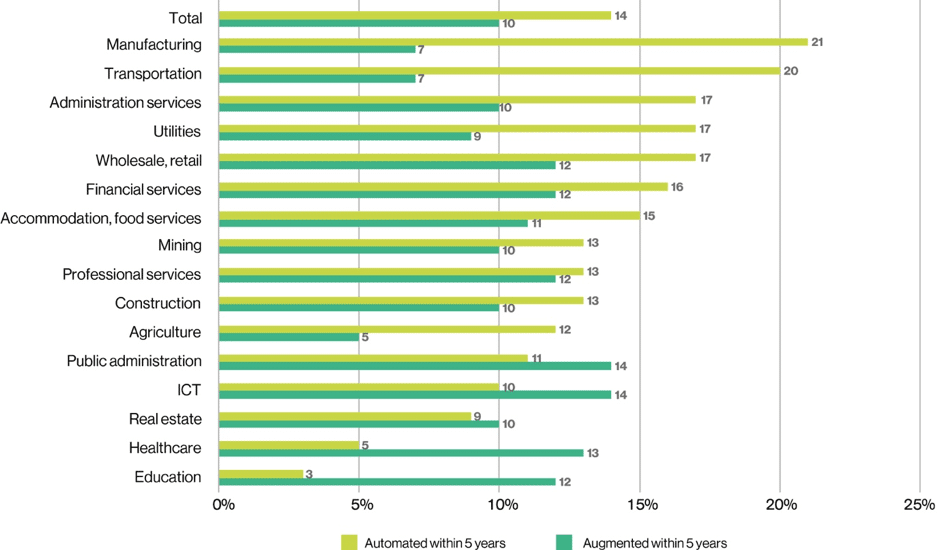
Source: Compiled by MIT Technology Review Insights using data provided by Faethm, 2019
In the face of this disruptive wave of technology, Malaysians are being proactive and taking the opportunity to learn new skills. According to the YouGov poll, over half of respondents are learning additional technological skills and this jumps to three-quarters amongst those who believe their roles are “very likely” to be replaced by technology.
This article was originally published on MIT Insights
In a room full of top industry executives who gathered in Kuala Lumpur for the Leap Summit in November 2019, a key question on the minds of business and IT leaders was: how can they implement a more coherent and cohesive digital transformation strategy rather than take a scattershot approach?
The answer could lie in tapping the power of creative disruption, a term coined by advertising professionals in the early 1990s to describe the changes in their industry arising from technological advancement and new ways of doing things.
A similar phenomenon is playing out across industries and cities today. In his keynote address on creative disruption at the event, Dan Cobley, managing partner at UK venture builder Blenheim Chalcot and former managing director of Google UK and Ireland, compared the cityscapes of Shanghai and Kuala Lumpur from 30 years ago to the present day.
“All of this amazing transformation is driven by a series of technology platforms evolving at an increasingly rapid pace. The adoption curve of new technologies by people is becoming steeper and we can see this by how long it takes for new technologies to reach a quarter of the population. Take the US as an example – it took 50 years for electricity to reach a quarter of the population – but the iPhone took just two years.”
The results are inevitable, he added. “If you believe, as I do, that disruption comes from the people who most effectively adopt new technology, then it is obvious that as technology adoption gets faster, the displacement of companies that are not adopting new technologies will also happen more quickly.”
Cobley underscored the increasing speed of displacement of companies by comparing their corporate lifespans. Noting that Fortune 500 companies held on to their status for about 60 years in the 1960s, their tenure in the elite group is just 20 years today and might be cut to 15 years in the next decade.
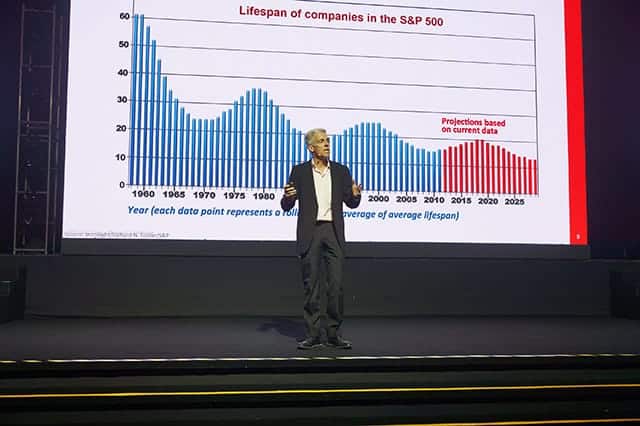
In a hard-hitting presentation, Cobley went on to emphasise that all sectors were affected.
“You should all worry – healthcare, telco, entertainment, banking and finance, agriculture, Energy will all be disrupted,” he said. “So, the clear imperative is to disrupt or be disrupted.”
But how should leaders kickstart the process of creative disruption and rapid transformation, and what should they be looking for?
To pave the way for creative disruption, Cobley called for businesses to first define the problem that they want to fix clearly. This could be a hugely inefficient process, or customers who have been badly served by a crisis, for example.
“Then develop an innovative solution, something enabled by some recent change. Lastly, we must have a motivated team, often with a crazy zeal and a mission to fix the problem.”
Among many examples, Cobley pointed to Google’s two founders, Larry Page and Sergey Brin, who gave up their PhDs to tackle the world’s information, the problem of a rapidly growing internet with sites numbering in the millions based on the old directory structure floundering under a basic keyword matching search engine.
“These two people set to work in a garage and tapped a new system to tackle the world’s information, made possible by powerful computers capable of analysing enormous datasets, and developed a site navigation search engine that looks at the authority of a site based on the sites linked to it.”
Cobley also shared recent examples of disruptive ideas from his own work, which include two financial technology companies he founded.
One of these companies, Salary Finance, sought to answer a widespread consumer finance problem in the UK, where about 70% of people applying for loans from a high street bank are declined due to fears of poor repayment.
“The solution was to work through the employer motivated by a growing awareness of employee well-being. There is a growing body of data linking mental well-being and financial stress. This startup offered an innovative structure, which reduced cost items such as customer acquisition, and so forth, borne by the bank,” said Cobley.
He said these examples demonstrate that a successful blueprint of creative disruption is driven by one or more of three factors: recent changes in regulation; a change in or a new technology; and a change in behaviour and expectations of customers.
“The reason is that most of what has been possible for centuries or decades has already been done,” he said. “But if there’s been a new change in regulation, technology or behaviour then that creates a new playing field. You have a chance to create something special.”
The next stage a company faces is the problem of scaling up, he said, noting that many companies have failed because of their inability to scale. However, scaling a disruptive idea needs to address three things: unit economics, the distribution challenge and execution.
“Distribution is key,” Cobley said. “Trusted partner collaboration underpins all of these three areas and accelerates growth.”
Cobley also shared the story of China’s Luckin Coffee, which has established 2,000 stores in eight months. With a new one opening every four hours, it has disrupted Starbucks in the country.
“Luckin’s business model delivers quality coffee which is 25% to 30% cheaper. The company uses mobile payments and has tapped new behaviour in China – the rising passion for coffee. It has made unit economics work by providing high-quality coffee through a take-and-go store.”
Cobley said to generate a disruptive business or enterprise unit, what is needed is something new and better (innovation), put in the hands of lots of people (distribution) and built on a platform.
Achieving all of that is a question of mindset, he added. While innovators seek change to solve a problem, achieve minimum price, take risks and have a long-term vision, he said incumbents prioritise stability to sell a product, maximise margins, avoid risks and look for short-term results.
“To shift to a disruptive mindset, you could reward people who dare, and not punish those who tried and failed. Incumbents are short term, and fixated on costs and shareholder pressure to maximise margins. As leaders, tackle the fear of failure, fail fast, make it very cheap and learn. Then, move on.

“If I am a leader in my organisation, am I removing the barriers to innovation and change? Do you have a percentage of your talent working on crazy stuff? Google, to avoid the incumbency trap, set up Google X to come up with radical new technologies to solve some of the biggest problems in the world,” Cobley said.
To remove innovation barriers, Cobley said organisations could set up an incubation unit like Google X, with non-financial metrics to encourage managed failure. He also stressed the importance of partnerships as most organisations don’t have the people to do the innovation.
In her keynote, Nora A Manaf, group chief human capital officer at Maybank, Malaysia’s largest bank by market capitalisation, talked about the importance of transforming people policies to keep up with the digital era.
“People and jobs are being disrupted and our workforce, our society, must be reskilled and upskilled. The wonders of technological disruption need to be complemented by getting the people factor in tandem with this digital transformation journey.”
With 375 million workers expected to change their occupational categories and learn new skills by 2030 to adapt to automation and digital transformation, going by McKinsey estimates, Manaf said it is necessary for companies to create a people-centric environment for employees to thrive.
“Letting people go is done by mediocre management, not by real leaders,” she said. “Leaders are risk takers – we have reimagined policies in Maybank and our thrust is about humanising financial services.”
For example, she said Maybank’s flexible work arrangements have bolstered the productivity of its staff. “Other work in free time is encouraged, provided there is no conflict of interest. Making staff independent is part of making a future-ready workforce.”
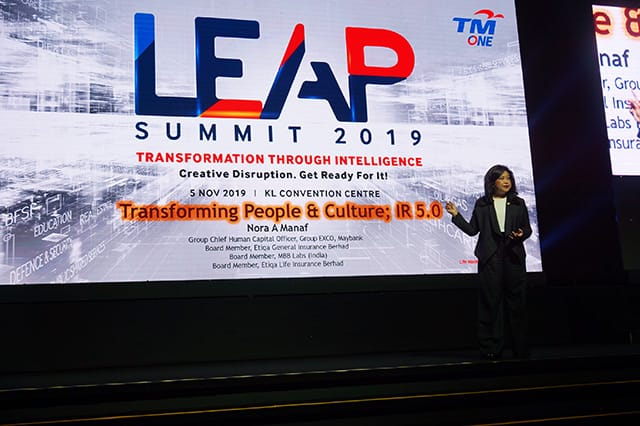
In his closing remarks, Ahmad Taufek Omar, executive vice-president and CEO of TM One, the digital arm of Telekom Malaysia and organiser of the Leap Summit, said while digital disruption is often perceived negatively, positive creative disruption is about reinventing continually.
“Every disruption pivots on creativity,” he said. “A new vision, a new insight of how technology can uplift people and their goals onto a more agile, faster path.”
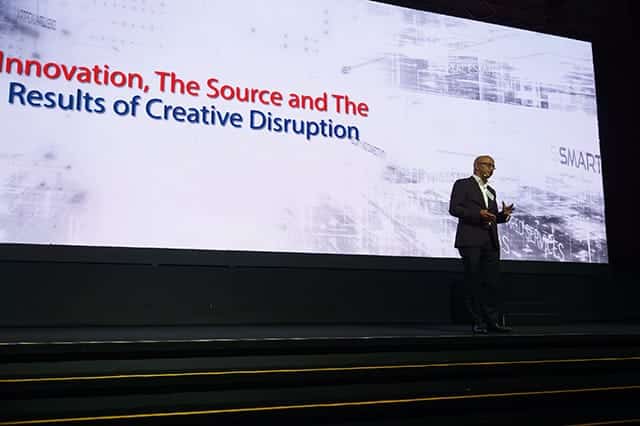
This article first appeared in ComputerWeekly.com